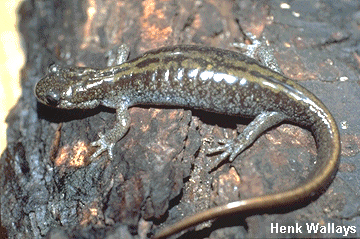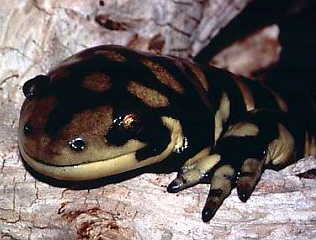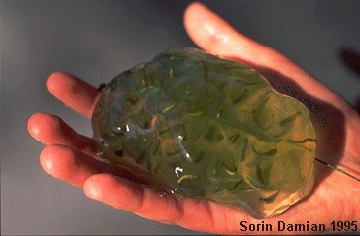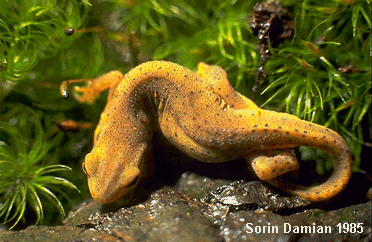

If you have a pond, you might find a strange critter in it one day. It will look
something like a lizard, with four sprawling legs and a long tail, but it will
have moist, fairly smooth skin and lack the scales lizards have. It is a
salamander!
Salamanders are related to frogs and toads in the group of animals called
Amphibians. This name means something like "living two lives," and refers
to the fact that many (but not all) of the animals in this group live part of their
lives in ponds, streams, or rivers, and part of their lives on land. Most of the
toads and frogs in North America lead such "double lives," and the water-
living forms are well known to most people as "tadpoles" or "pollywogs."
In fact, many of the salamanders found in North America never
venture into water to live, but lay their eggs in moist, hidden sites such as underground hollows, decaying logs, or in
wet, drippy, moss-covered rock
piles. The little guys that emerge from these eggs are miniature versions of
the adults.
underground hollows, decaying logs, or in
wet, drippy, moss-covered rock
piles. The little guys that emerge from these eggs are miniature versions of
the adults.  But some salamanders, including some
pretty
common and
well-known ones, do lay their eggs in water and have an aquatic stage to
their life cycles, and these are the ones you might see in your pond. You
may hear them referred to as "water dogs." The larval forms of these pond-
breeding salamanders have finned tails like tadpoles, but have four legs and
feathery, external gills.
But some salamanders, including some
pretty
common and
well-known ones, do lay their eggs in water and have an aquatic stage to
their life cycles, and these are the ones you might see in your pond. You
may hear them referred to as "water dogs." The larval forms of these pond-
breeding salamanders have finned tails like tadpoles, but have four legs and
feathery, external gills.
Two major groups of salamanders breed in ponds in North
America,
the mole salamanders and the newts. The adult, land-dwelling forms of
mole salamanders are often found in underground burrows, thus the name.
The most common and widespread salamander over much of North
America is a kind of mole salamander,  the
Tiger Salamander (a variety of forms occur in different parts of the country,
some considered separate species by some biologists). Tiger Salamanders
are found from the Pacific Northwest east to the Atlantic states and south
into Mexico. Adults can get pretty big, over a foot long! In many parts of the
Great Plains, Rocky Mountains, and the Southwest, Tiger Salamanders are
the only kind of salamander present. A related species, the California Tiger
Salamander, occurs in the foothills and valleys of California.
the
Tiger Salamander (a variety of forms occur in different parts of the country,
some considered separate species by some biologists). Tiger Salamanders
are found from the Pacific Northwest east to the Atlantic states and south
into Mexico. Adults can get pretty big, over a foot long! In many parts of the
Great Plains, Rocky Mountains, and the Southwest, Tiger Salamanders are
the only kind of salamander present. A related species, the California Tiger
Salamander, occurs in the foothills and valleys of California.
Tiger Salamanders and most other mole salamanders such  as this Long-toed Salamander typically
emerge from underground retreats with heavy spring rains (or winter rains in
California) and migrate, mainly at night, to their breeding ponds.
Salamanders and newts that migrate to breed face a growing danger -- the
proliferation of roads and cars between their upland homes and their
breeding ponds. In some areas, many migrating salamanders and newts
are killed by cars on rainy nights. "Newt Crossing" and "Salamander
Crossing" warning signs have even been erected by concerned folks along
some roadways where salamander and newt migration traffic is particularly
heavy!
as this Long-toed Salamander typically
emerge from underground retreats with heavy spring rains (or winter rains in
California) and migrate, mainly at night, to their breeding ponds.
Salamanders and newts that migrate to breed face a growing danger -- the
proliferation of roads and cars between their upland homes and their
breeding ponds. In some areas, many migrating salamanders and newts
are killed by cars on rainy nights. "Newt Crossing" and "Salamander
Crossing" warning signs have even been erected by concerned folks along
some roadways where salamander and newt migration traffic is particularly
heavy!
 After
courting in the pools, the males deposit sperm packets that are picked up by
the females and used to fertilize the eggs internally. The females then lay
egg clusters enclosed in a jelly-like substance. Pond salamander eggs,
especially those of mole salamanders like the Tiger, look a lot like frog eggs.
They may be laid in clusters or singly, depending on the species. Newt
eggs are similar but have a little more "body" (firmer case). The baby
salamanders emerge from these eggs after a few weeks, living off yolk
reserves for a while, but eventually turning into hungry predators of just
about anything that moves in the pond and is small enough to eat. They are
even known to eat other salamander larvae! At the end of the summer they
usually transform to the adult, land-living form and leave the breeding ponds
before they dry up (in northern latitudes and high altitudes the larvae may
over-winter in the ponds, under the ice, and transform the following year). In
some areas the larvae are "neotenic" -- they never transform to a terrestrial
adult but reach sexual maturity in the larval form and breed and remain in
the water all their lives.
After
courting in the pools, the males deposit sperm packets that are picked up by
the females and used to fertilize the eggs internally. The females then lay
egg clusters enclosed in a jelly-like substance. Pond salamander eggs,
especially those of mole salamanders like the Tiger, look a lot like frog eggs.
They may be laid in clusters or singly, depending on the species. Newt
eggs are similar but have a little more "body" (firmer case). The baby
salamanders emerge from these eggs after a few weeks, living off yolk
reserves for a while, but eventually turning into hungry predators of just
about anything that moves in the pond and is small enough to eat. They are
even known to eat other salamander larvae! At the end of the summer they
usually transform to the adult, land-living form and leave the breeding ponds
before they dry up (in northern latitudes and high altitudes the larvae may
over-winter in the ponds, under the ice, and transform the following year). In
some areas the larvae are "neotenic" -- they never transform to a terrestrial
adult but reach sexual maturity in the larval form and breed and remain in
the water all their lives.
Two general kinds of Newts, with three species each, are found in
North America. The West Coast Newts, including the very similar brown-
and-orange California and Rough-skinned newts,  have life-styles something
like those of mole salamanders. They, too, migrate to water, usually in the
winter or spring, to mate and lay eggs. The eggs undergo similar
development and produce similar larvae, which transform to rough-skinned,
land-dwelling adults. Unlike mole salamanders, however, western newts
going to or from breeding ponds are often seen walking around in broad
daylight in damp or rainy woods. Probably the reason they are so brazen is
that these newts produce a potent skin secretion which repels most
predators. For this reason, if you have to handle a newt, always wash your
hands well afterwards, and NEVER put one in your mouth!
have life-styles something
like those of mole salamanders. They, too, migrate to water, usually in the
winter or spring, to mate and lay eggs. The eggs undergo similar
development and produce similar larvae, which transform to rough-skinned,
land-dwelling adults. Unlike mole salamanders, however, western newts
going to or from breeding ponds are often seen walking around in broad
daylight in damp or rainy woods. Probably the reason they are so brazen is
that these newts produce a potent skin secretion which repels most
predators. For this reason, if you have to handle a newt, always wash your
hands well afterwards, and NEVER put one in your mouth!
 The eastern newts, including the common and widespread Red-spotted
Newt, have a more complex life-style. The larvae may or may not develop
into a rough-skinned, land-dwelling form, called a "red eft" because of its
bright red-orange color (this is probably a warning color to predators, as
these newts are poisonous, too). The red efts eventually return to water
after a few years and transform into aquatic adults, which breed and spend
the rest of their lives in water. In some populations, however, the red eft
stage is skipped altogether and the larvae transform directly into aquatic
adults.
The eastern newts, including the common and widespread Red-spotted
Newt, have a more complex life-style. The larvae may or may not develop
into a rough-skinned, land-dwelling form, called a "red eft" because of its
bright red-orange color (this is probably a warning color to predators, as
these newts are poisonous, too). The red efts eventually return to water
after a few years and transform into aquatic adults, which breed and spend
the rest of their lives in water. In some populations, however, the red eft
stage is skipped altogether and the larvae transform directly into aquatic
adults.
Now that you know something about the lives of newts and
salamanders that breed in ponds, you might keep an eye out for them in
your pond. They have a tough time breeding in ponds that contain fish,
though, because many fish will prey on the eggs and young. They may be
able to breed in very large ponds or streams containing fish if there is
sufficient submerged vegetation for cover.

To see more images of salamanders you are encouraged to visit TRITON: Amphibian images by Sorin Damian where I discovered many of these fantastic images. Thank-you Sorin.
You are also encouraged to email Tim Manolis and let
him know how much you enjoyed this article.